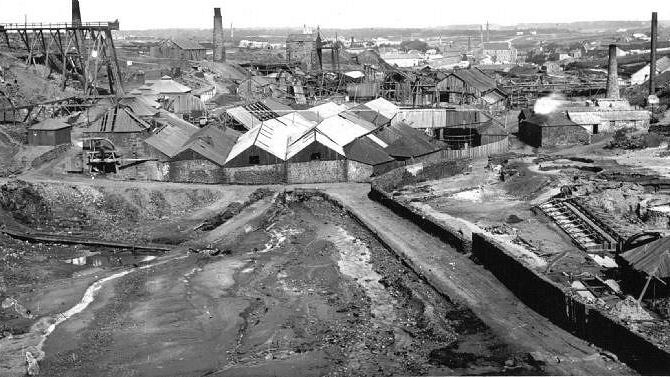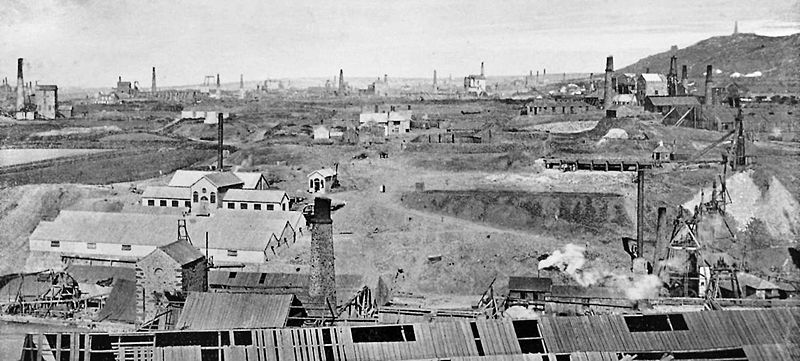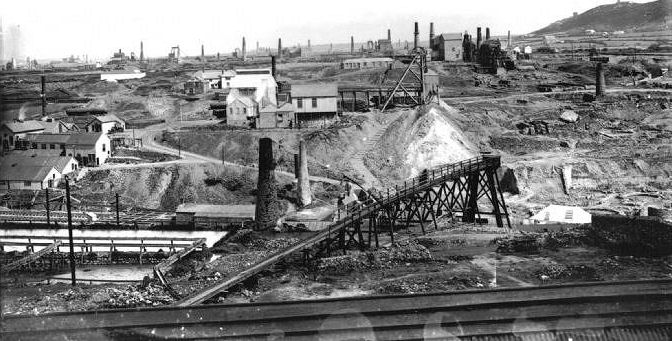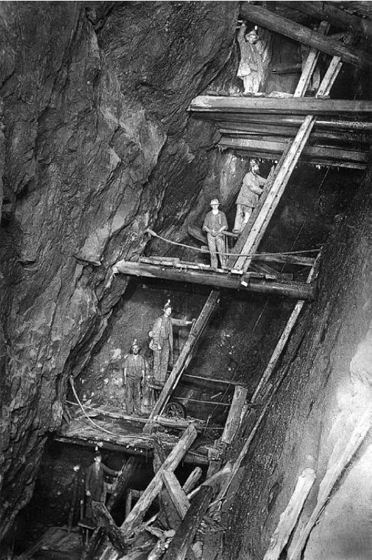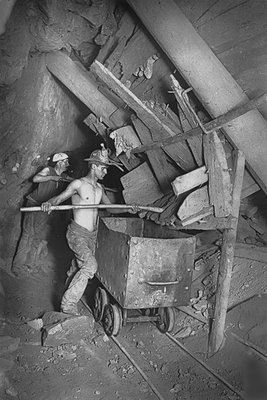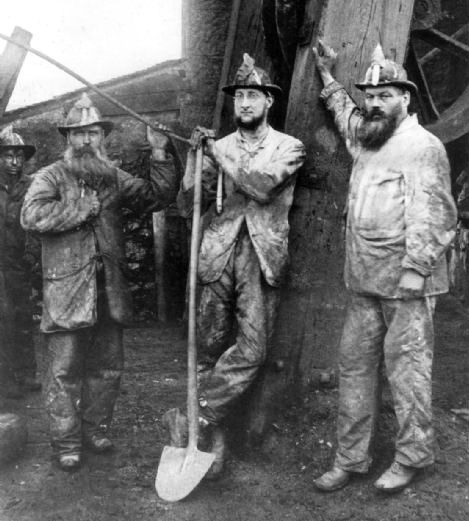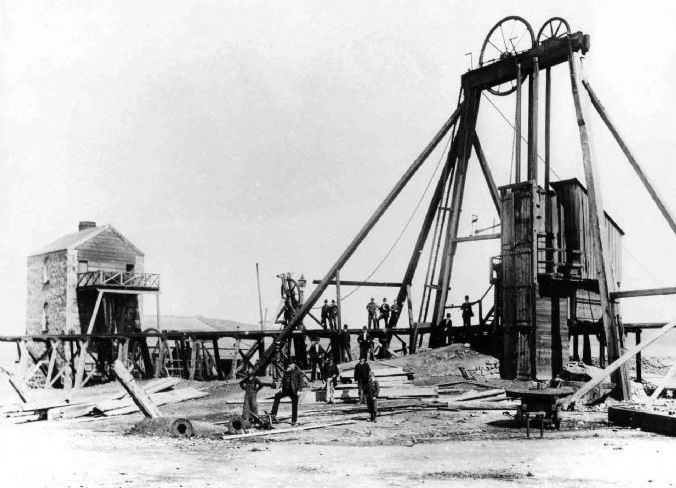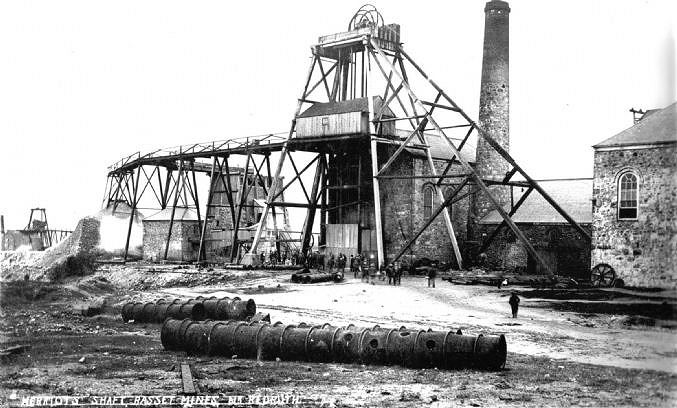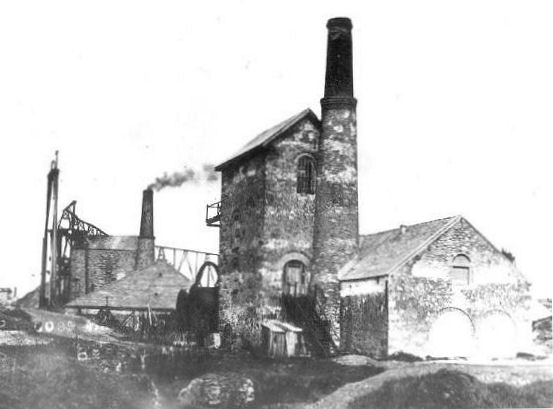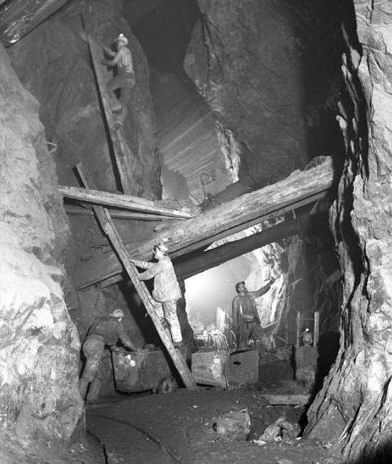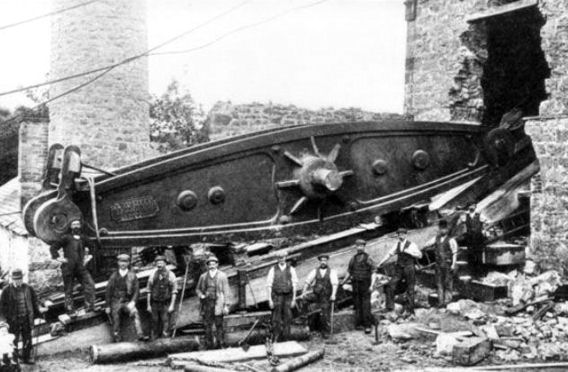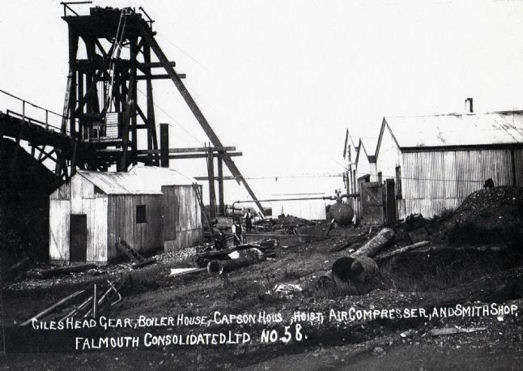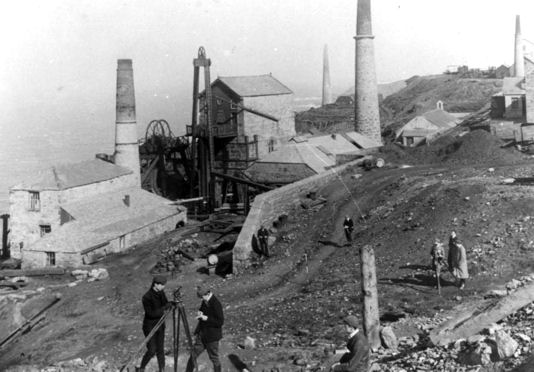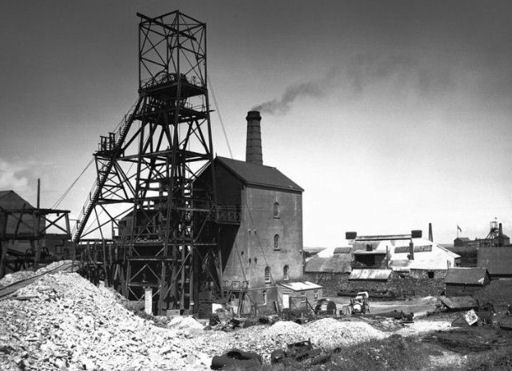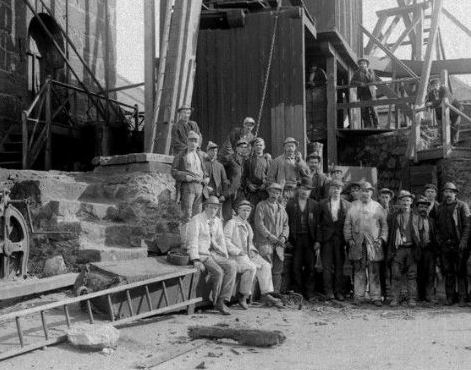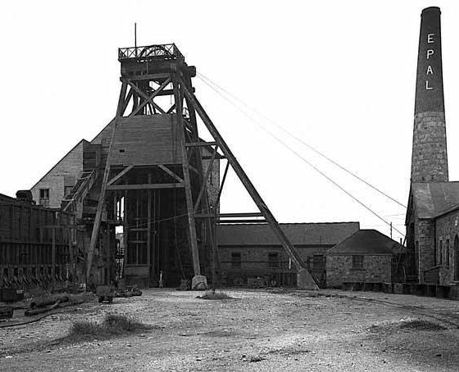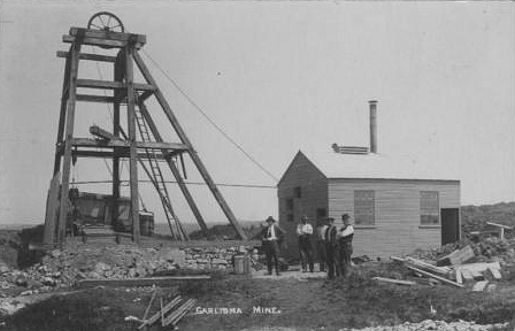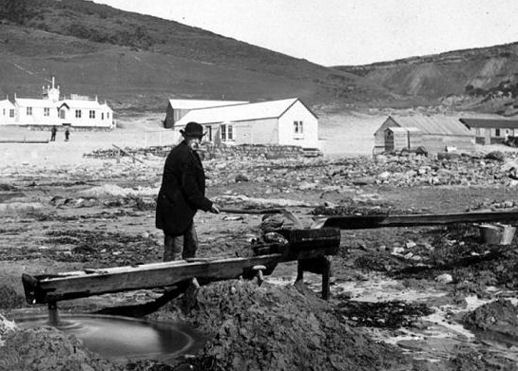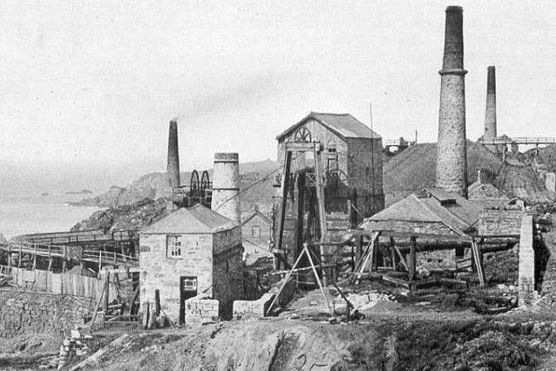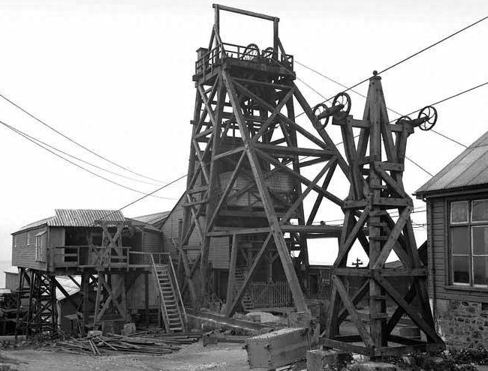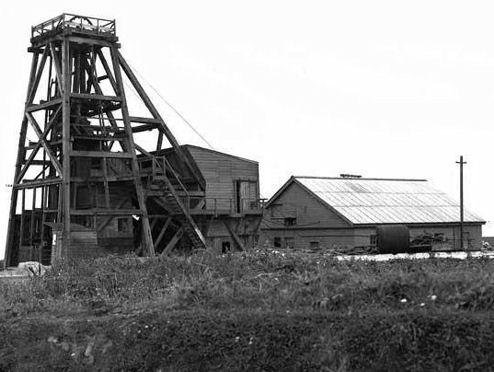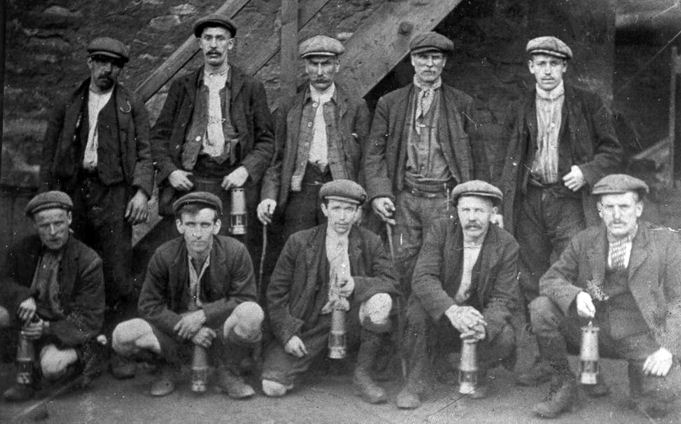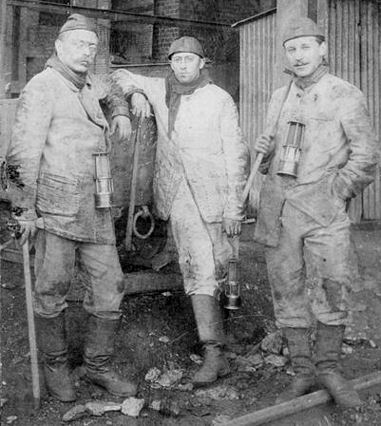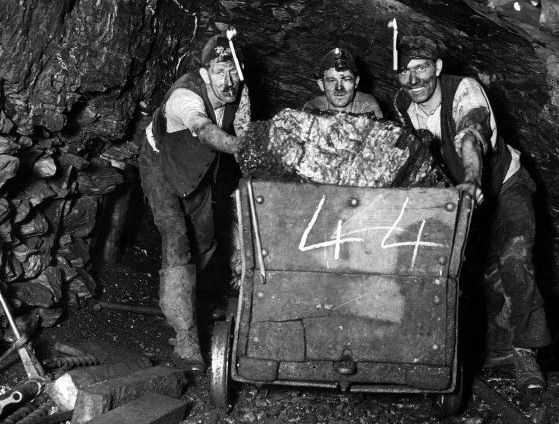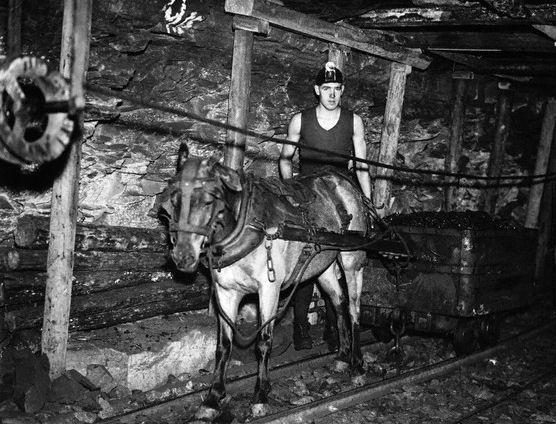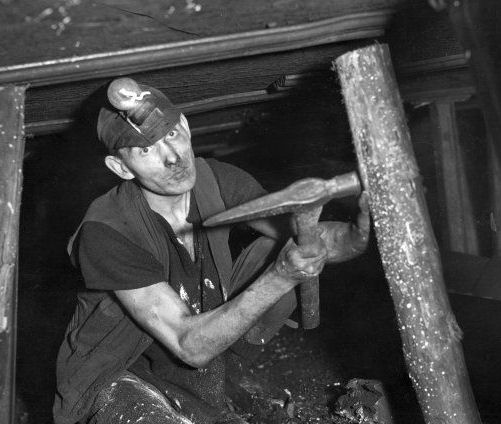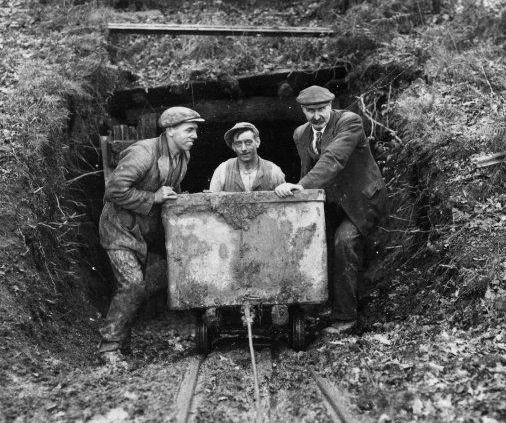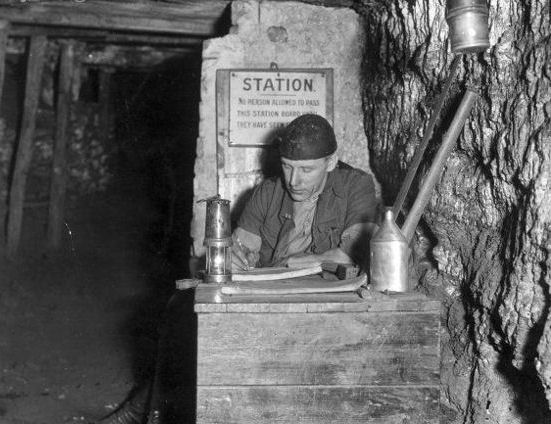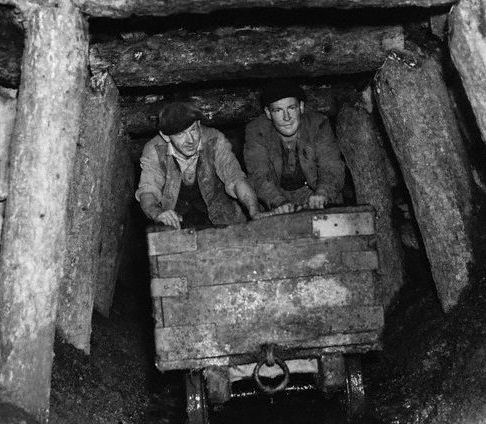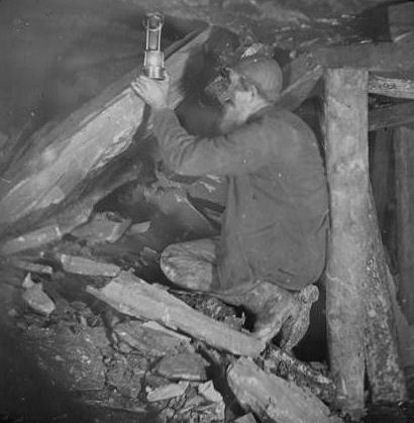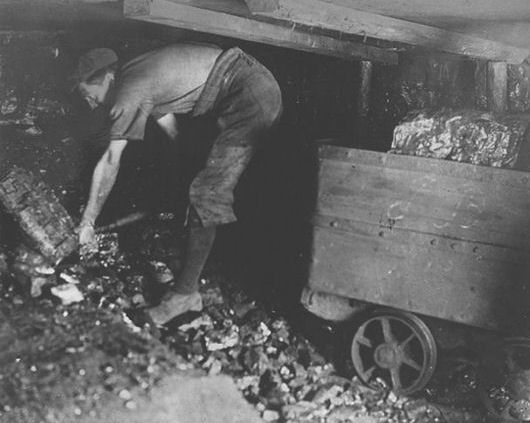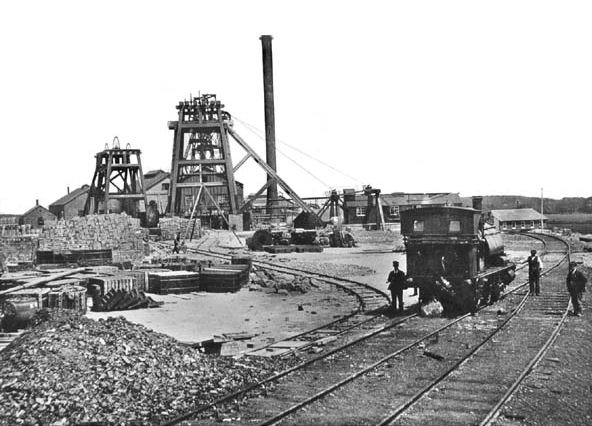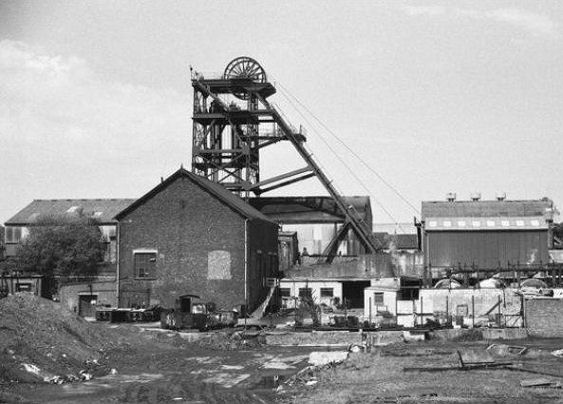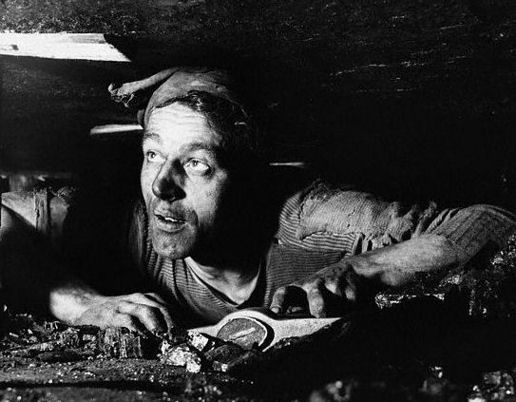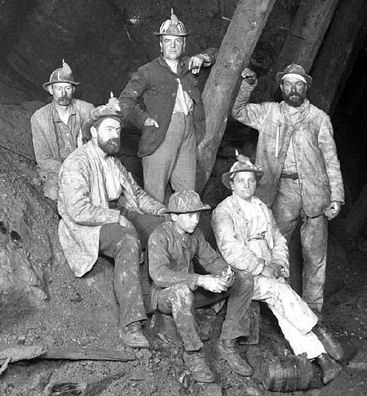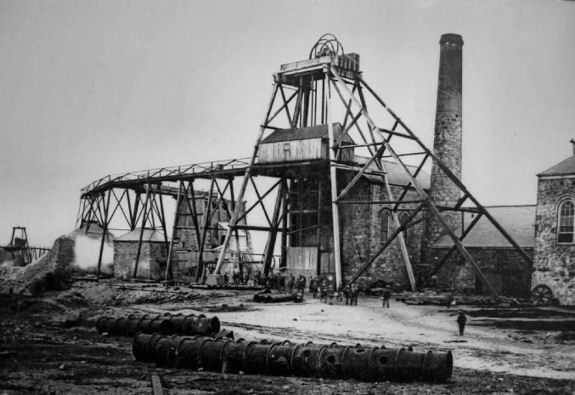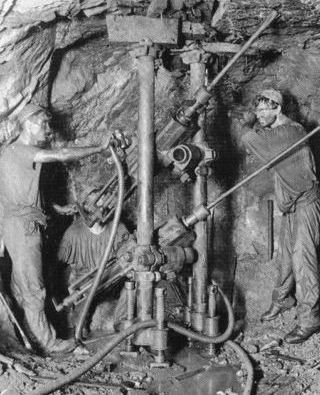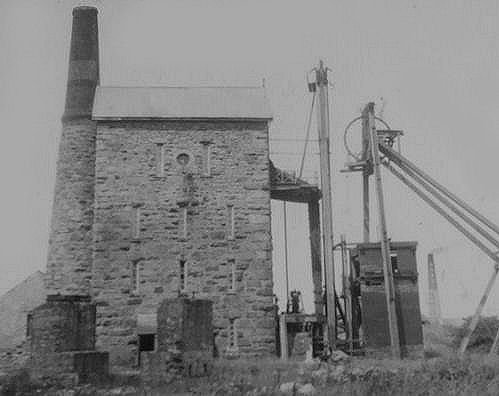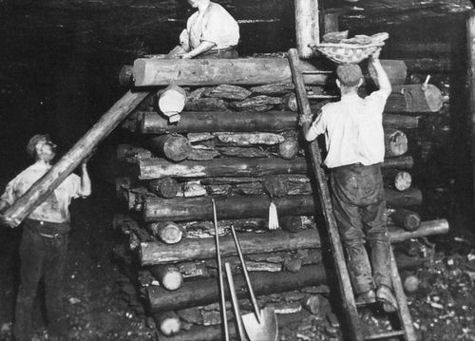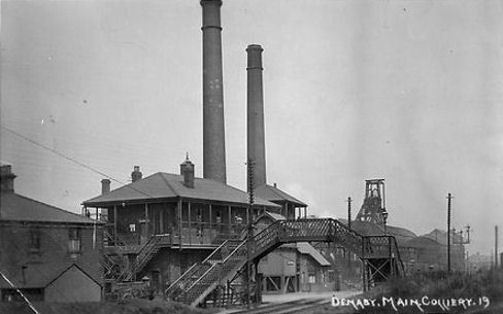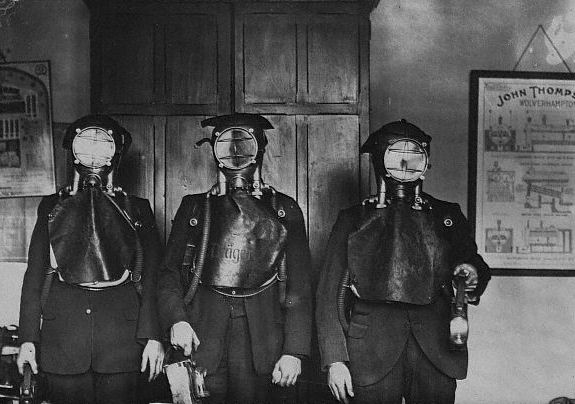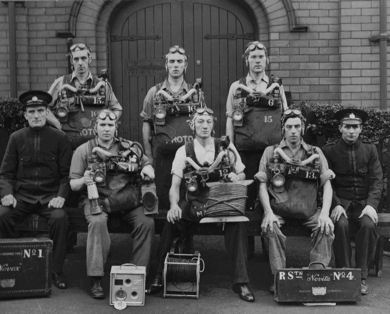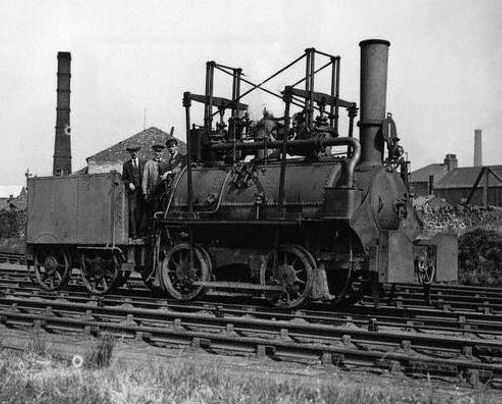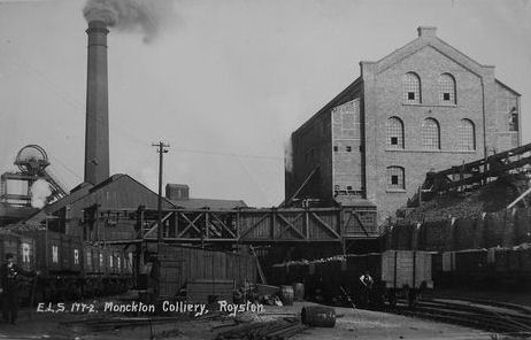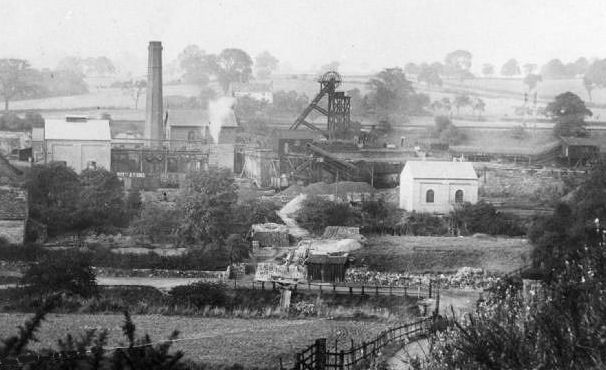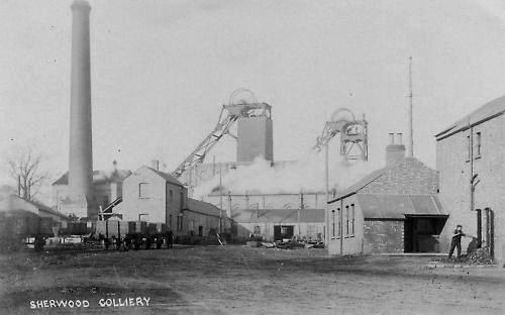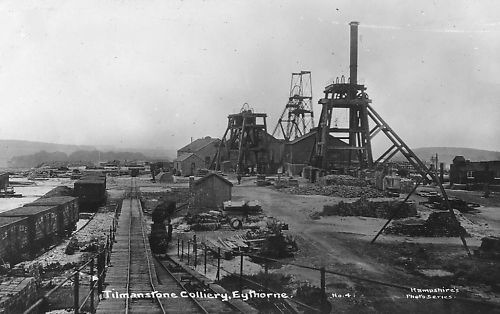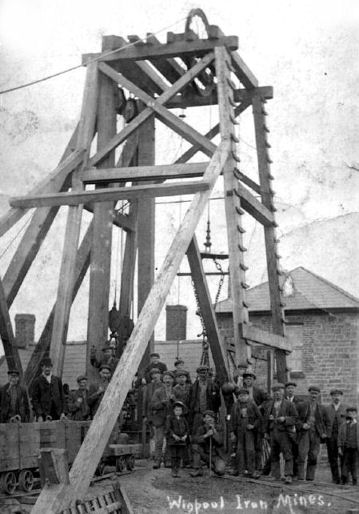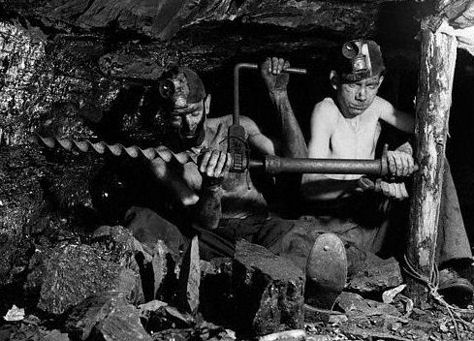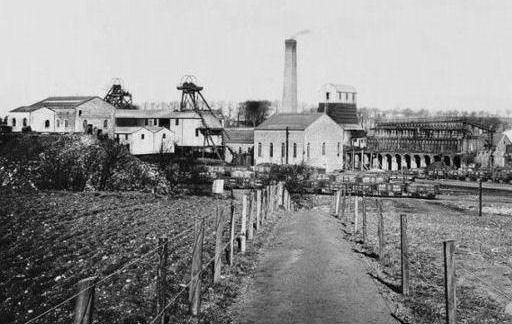Mines of England
Mining in Cornwall and Devon began in the early Bronze Age approximately 2,300 BC and ended with the South Crofty tin mine in Cornwall closing in 1998. Tin and later also copper were the most productive of the metals extracted: some tin mining continued long after mining of other metals had become unprofitable. From the early settlers who arrived in Cornwall from Europe around 2300 BC, to the later half of the 17th Century, Cornish mining was largely limited to surface mining. Extensive tin and copper mining has occurred in Cornwall and Devon, as well as arsenic, silver, zinc and a few other metals.
It wasn't until the 18th Century and the invention of machine driven pumps, that Cornish tin mining became a truly capitalist concern. Mine shafts inevitably dropped below water level, so prior to this date, shallow mining was the only way to extract the tin and copper from the ground.
The machine driven pump was powered by steam engine and was capable of lifting hundreds of gallons of water per minute from great depths. In 1710, the first steam driven water pump was installed in Cornwall, allowing deep mining to take place for the first time. These pumps were so successful that the output of tin and copper rose prodigiously and Cornwall became the home of deep mining. This technology was adopted in mining regiojns around the world.
Despite the collapse of the copper mining industry in 1866, the tin industry was still riding high producing 10,000 tons of tin a year - about half the world's production. At one time Cornwall boasted 2,000 tin mines and it was a world leader in tin production. In 1872, tin was discovered in Queensland, New South Wales and Tasmania. Tin fever swept Australia. Competition from Malaya and Bolivia was the final nail in the coffin of Cornish tin mining and between 1871 and 1881 it is estimated that a third of Cornwall's mining population emigrated in the face of unbearable hardship at home. Within half a century of the tin boom of 1870-72, the industry was almost dead in the face of foreign competition. During the 20th Century, the tin mining industry careered from boom to bust, with boom experienced during the war years, firmly countered by the bust of the 1930s.
A handful of mines survived, largely through amalgamation - South Crofty in Camborne, was one of them. By 1960 South Crofty had control of nearly six square miles of mineral land. Demand was high, wages were good, but there was a shortage of men willing to work underground. Although various ores became briefly profitable during the 20th Century, they were unsustainable and on March 6, 1998 the pumps at South Crofty, the UK's last tin mine, were finally turned off for good.
Modern attempts to work Cornish Copper ores for profit had started in the 16th century with imported German expertise. They failed and little was done for most of the 17th century. However, improved smelting techniques, largely connected with the introduction of the reverberatory furnace at the end of that century, finally began to make their exploitation viable and mining began to expand during the early 18th century.
Copper mining experienced steady growth from the beginning of the 18th century. From 1750 to 1850 copper was the most important mineral in the region.Cornwall's copper output dominated the world’s copper markets.
Technical advances in stream pumping shaped the beginning of the Industrial Revolution in Cornish mining. The creation of the industrial transport infrastructure during the late 18th century was essential to the production of copper.
In 1785 the exploitation of the large and shallow deposit of copper ores at Parys Mountain in North Wales caused a sharp economic decline in the fortunes of Cornish Mines. During this period, British copper production exceeded demand, and there were struggles for the control of the copper market between smelters and Cornish producers caused a surplus of copper on the world market. Triggering many mine closures. However, the copper ore in North Wales were worked out within 20years and during this time Cornish miners had made huge improvements in pumping technology and working methods. During the early years of the 19th century Cornwall had once again become the top copper ore producer in Britain, and the world. This remained so for several years.
In the 1830s Cornwall completely dominated world copper production. Gwennap Mines produced 442,493 tons of copper between 1819 and 1858 and the United Mines produced 347,640 tons from 1815-1861: this area was so rich in copper it was called the ‘Copper Kingdom’. However two decades later Chile’s production outdid Cornwall’s copper output. Cornwall and Devon’s peak year for copper production was 1855-1856, when 209,305 tons of ore were mined. By the end of that decade tin replaced copper as the regions most important mineral. In 1866 there was a crash in the copper market and Cornish copper mining could not survive.
Some Cornish mining districts were fortunate as they also possessed tin reserves, and they were able to continue to function as Tin mines. These tin deposits were generally found at greater depths than the copper deposits., as the mines grew deeper, the tin deposits became richer.
Cornwall was the principal source of tin for countries in northern Europe; though in the first centuries BC and AD the Mediterranean region may have obtained their supplies from Iberia. Tin production was probably the main reason that the Romans ventured into this part of Dumnonia. The nearest Roman town was Exeter but small forts have been found in Cornwall, together with Roman milestones and hoards of Roman coins. A Roman fort at Tregear (Nanstallon) near Bodmin is close to an ancient ford and some important early tin workings.
A substantial amount of tin output in the region came from tin-streaming. Until the eighteenth century most tin came from these deposits. The alluvial tin deposits north of the St Austell china clay district at Goss Moor, Tregoss Moor, Molinnis Moor, Redmoor and Breney Common are the sites of the largest and most important alluvial tin workings in Cornwall. Though worked from prehistoric times, large scale mining in the early twentieth century, using suction and bucket ladder dredges, was successful.
Tin was in considerable demand for manufacturing both bronze and pewter and there is strong archaeological evidence for trade between Cornwall, the eastern Mediterranean and northern Europe. The Trewhiddle Hoard (Pentewan) of late ninth-century silver is thought to have been hidden from invading Danes in a working tin stream. An oak tinners’ shovel found in Boscarne tin stream (Bodmin Moor) has been radiocarbon dated to between AD 635 and AD 1045. Church bells, whose bronze depended on Cornish tin, were widespread by AD 1000. Cornwall and Devon sustained an internationally important medieval tin industry. Shallow mining effectively mapped the major areas where tin occurred; copper at this time still being of little commercial interest
From the eighteenth century lode mining became dominant. There was a virtual absence of world competition in tin mining until the 1820s and the market remained dominated by Cornish tin until the 1870s. Periods of increased demand, such as the rapid rise of the tin-plate industry after 1800, strongly influenced the metal market price and hence production levels. The ability to increase production however depended upon the available mining technology of the time. The introduction of gunpowder for blasting and of reverberatory furnaces for smelting began a rising trend in production towards the end of the seventeenth century. From 1700 there began a steady improvement in the understanding of the nature of tin mineralisation and hence the ability to predict where tin deposits might lie. The development towards an industrial economy, with the ability to raise risk capital from investors, was a crucial factor that enabled expansion of the industry.
The improvement of steam pumping technology during the second half of the eighteenth century, and dramatic improvements to the Cornish engine from the 1820s enabled deeper mining and greater output. Cornish tin mines survived the threat of competition during the 1820s and 1840s from producers in the Far East. Following the 1866 copper crash, and the closure of a large percentage of Cornish copper mines, tin mines became the principal mines in the nominated Site. The 1870s marks the peak production period at a time when Malayan production was temporarily halted by internal political anarchy. From 1874 production declined as Australia and Malaya produced a large output from extensive shallow deposits of cheaply exploited ore that continued to be mined through the 1880s and 90s. The consequent drop in the tin price, coupled with a decline in investment and the irony of a shortage of miners due to emigration, caused production to continue to fall sharply. It was not until the second half of the twentieth century that there was a substantial recovery in output. This followed a programme of financial support targeted at the mining industry by the United Kingdom.
Copper
In 1785 the exploitation of the large and shallow deposit of copper-rich sulphide ores at Parys Mountain on Anglesey (North Wales) precipitated a sharp economic downturn in the fortunes of many Cornish mines. During this period, British copper production exceeded demand by a large margin, whilst a struggle for the control of the copper market between the smelters and the Cornish producers resulted in a glut of copper on the world market; inevitably this was followed by numerous mine closures.
In the event, the readily-exploitable ores at Parys Mountain were worked out within two decades. Meanwhile the Cornish had responded to this threat to their mining economy through marked improvements in pumping technology and better working methods. During the early years of the nineteenth century Cornwall had once again become the pre-eminent copper ore producer in Britain, indeed, in the world; and was to remain so for several decades.
The Consolidated Mines in Gwennap produced 442,493 tons of copper ore between 1819-1858, and the adjacent United Mines 347,640 tons from 1815-1861; the area was so rich that it was dubbed ‘the Copper Kingdom’. In the 1830s Cornwall completely dominated world copper production. However, two decades later Chile's production far exceeded Cornwall's output and the Lake Superior mines (N. America) and those in South Australia were developing fast. Cornwall and Devon's peak year for production was 1855-6, when 209,305 tons of ore were mined. By the end of that decade tin was replacing copper as the region’s most important mineral, particularly in its western mines, and in 1866 a disastrous crash in the copper market occurred which Cornish copper mining could not survive. Chile, Australia, Lake Superior, Montana, and Arizona spelt the end for Cornish copper mines and for the Welsh smelters. Some Cornish mining districts were fortunate in that they also possessed tin reserves, and through increasing mechanisation and the adoption of efficient ore-dressing technology, their mines were able to work on towards the end of the century, despite falling tin prices. Some former copper mines found a new lease of life in working the arsenical pyrite which they had formerly discarded as waste. Devon Great Consols in the Tamar Valley produced nearly two-thirds of the world's arsenic during the closing years of the nineteenth century. Nevertheless, the great days of Cornish mining were over and, one by one, mines whose reputation had spread far beyond Cornwall were abandoned.
Arsenic
During the early nineteenth century Cornwall pioneered world arsenic production as a by-product of tin and copper mining in the western part of the nominated Site (Gwennap Mining District). The first commercial British arsenic was produced at Perran-ar-Worthal in 1812, followed by a works at Bissoe (1834) in the Carnon Valley that became a stronghold of arsenic production. Its principal market was the expanding Lancashire cotton industry which used it in pigments and dyes.
It was also used by other industries such as glass manufacture (as a decolouriser), in the production of lead-shot, in leather tanning, in wallpaper manufacture (to create green and yellow print), in pharmaceuticals, in agriculture for sheep dips and, from the 1870s, as a pesticide to control the Colorado beetle which devastated potato, tobacco and other crops in America during the late nineteenth century.
The principal arsenical insecticides were Paris green (from 1869) superseded by London purple (from 1878). During the latter half of the nineteenth century the leading world output came from the eastern part of the nominated Site (Tamar Valley). Production of this semi-metal prolonged prosperity long after other metalliferous productions had declined.
Calciners or ‘burning houses’ (furnaces) were an essential part of most eighteenth century Cornish tin mines whose ores contained arsenic and sulphur. These essential elements had to be ‘cleansed out’ by roasting as they proved deleterious to smelted tin. It was not until the nineteenth century however that demand arose, induced by technological advances, for the white arsenious oxide.
For some flagging copper mines, the working of arsenic provided several more years of profitable work and in some cases these ores became their principal output. Substantial works were established at the English Arsenic Company factory at Roseworthy, Gwithian and at Greenhill near Gunnislake, but the largest in the region was at Devon Great Consols, which at its peak produced 3,000 tons of refined arsenic a year. It was in the 1870s that a handful of mines in the Tamar Valley mining district were producing over half of the world’s arsenic; the works at Wheal Anna Maria (part of Devon Great Consols) covered 3.2 hectares and had over 6,850 cubic metres of arsenic flues.
Silver Mining
The Bere Old Mines, together with those at Combe Martin in north Devon, dominated English silver production until the late sixteenth century. In the late thirteenth and fourteenth centuries a fundamental change took place in local mining organisation when the Crown - apparently prompted by the desire to maximise its income from silver mining - worked the Devon silver-lead mines directly by shaft mining. For the first time small-scale independent operations were replaced by a relatively large-scale capital-intensive mining organisation that laid the foundation for an entrepreneurial system - the Cornish tribute. This dominated non-ferrous metal mining, in Britain and in many overseas mining fields into the modern period.
Skilled miners were drawn from other British lead mining districts, many of whom were pressed into service. Workings were initially shallow but adit drainage was required by 1297 when output peaked. In the early fourteenth century the workings were rich but again impeded by water. Crosscut drainage adits had to be driven deeper. When the Black Death hit the South West of England in 1348/9 the mines were reduced to the reworking of slag residues. Underground working was abandoned.
Copper Mining
The earliest recorded attempts to mine Cornwall’s copper ores had been in the 1580s by The Society of Mines Royal (which had first worked the Keswick deposits in Cumbria on a large scale). The Cornish mining operations took place in St Just, St Agnes, Perranzabuloe, Illogan, Marazion and St Hilary. Ulrich Fosse (a German mining expert) was sent to Cornwall to manage operations and under his direction a small smelting works was also set up at Neath in South Wales. This smelter operated under German management and copper ore was received from mines near St Ives and St Just. Carew in his Survey of Cornwall (1602) mentions the shipment of copper ore from St Ives to be refined in Wales: the beginnings of a long-standing relationship between Cornwall and South Wales.
These early copper mines were unsuccessful and significant exploitation did not begin until the passing of the Mines Royal Acts of 1689 and 1693. During the last years of the seventeenth century, copper production largely progressed as a result of the efforts of a copper smelter named John Coster who had established works on the River Wye, Herefordshire in 1680. He was a metallurgist and engineer who also helped to further develop adit drainage, to make significant advances in assaying and dressing copper ore, erected one of the first horse-whims in Cornwall and developed its first true copper mine at Chacewater in the early 1700s.
Steam Engines
In Cornwall the ingression of water was the worst problem in shaft mining. A deep mine is a bit like a water well. You have to pump the water out constantly. The staem engine driving a pump was the answer to allowing deep mining in Cornwall.
By the late 1700s huge beam engines dotted Cornwall. By 1760, most steam engines were of a type developed by Thomas Newcomen . They had a vertical open-topped cylinder inside which a close-fitting piston was hung by a chain attached to a rocking beam. From the other end of the beam, pump rods were attached to a water pump. Steam entered the cylinder at very low pressure, was quickly condensed by a jet of cold water, this created a vacuum. The difference from atmospheric pressure drove the piston down, which in turn raised the pump rods and operated the pump action.
In 1763-4 James Watt, working as instrument-maker for Glasgow University, carried out experiments on a model Newcomen engine and realised that he could improve the fuel efficiency of the Newcomen engine. Watt discovered in 1765, that fuel could be saved by condensing the steam in a separate condenser. This allowed the cylinder to remain at a constant temperature.
This simple innovation reduced the coal consumption of the Newcomen engine by two-thirds. Such a saving was wonderful for a place like Cornwall, where coal had to be expensively transported to operate the steam engines. Watt formed a partnership with Matthew Boulton in 1775 and started to produce his own engines for mine pumping. He then went on to develop a 'rotative' steam engine suitable for driving machinery in factories.
In 1780, James Pickard of Birmingham patented the crank, which converted the vertical motion of the piston into the rotary motion of a flywheel. Watt had to develop an alternative gearing system and made these engines until 1802. These engines could drive the machinery in the textile mills, and represented around 60 percent of the 500 engines built by Boulton and Watt before 1800.
Boulton and Watt found it difficult to keep up with the demand for steam engines. As orders for their engines increased, a shortage of skilled engine erectors meant that engines could not be installed quickly enough. In addition Boulton and Watt offered little after-sales service, so a breakdown could mean a lengthy stoppage. After 1800 the situation improved; Boulton & Watt began to standardise their engine designs and working procedures, making assembly quicker and easier.
James Watt, like the Wright brothers a hundred years later, slowed technological developments by his guarding of his patent rights. However the end of Watt's patent in 1801 allowed local engineers to experiment with further improving the beam engine. The development of the Cornish boiler and high pressure working by Richard Trevithick was significant and the beam engines which emerged in the early part of the 19th century were to power Cornish and Devon mines for the whole of the following century.
Dolcoath Mine
Dubbed 'The Queen of Cornish Mines', Dolcoath was originally a copper mine - output over 350,000 tons - the fifth largest producer in Cornwall and Devon; yet the sixty-seven years between 1853 and 1920 saw it yield the largest output of any Cornish mine of black tin, over 100,000 tons!. Dolcoath as we know it today is actually an amalgamation of several other smaller mines including Stray Park (1871), Bullen Garden Mine and Roskear. The mine began working in the early 1700's and was over 300 feet deep by 1746. It closed between 1788 and 1799 during the 'Great Copper Slump' when cheap copper from Parys Mountain in Anglesey flooded the market. On reopening, it grew to become the largest and deepest mine in Cornwall. Between 1799 and 1920 the value of its production was over £10 million (for all minerals). Other minerals of note included ores of arsenic, tungsten, lead, silver, bismuth, cobalt and even uranium.
As the copper ores were mined out, tin was discovered at the lower levels. It mined six different lodes including the Caunter Lode. The principal shafts being at Harriet's, Valley Shaft and Old Sump Shafts. Several other new shafts were sunk at the end of the 19th century such as the New Sump Shaft and New East shaft. Its main Williams Shaft - incidentally named after its chairman Mr. Michael Henry Williams - had an exceptionally rich lode at the 412 fathom (2472 feet) level and the sinking of the shaft began on 26th October 1895. However shortly after World War One, tin prices fell drastically, with new deposits found elsewhere in the world. The once mighty Dolcoath shut in 1921.
East Pool & Agar, Ltd.
East Pool began life as 'Poor Old Bal' copper mine in the early 1700's. Its sett was leased from the Basset family and produced enough profit to construct their imposing family home at Tehidy. The mine worked until 1784 as a copper mine and re-opened in 1834 selling 105 tons of copper ore in 1834. The ore was of very high grade commanding a price of £12.304 per ton in 1835 as against the local average of £5.952. The mine continued working now until 1897 when it amalgamated with the nearby Wheal Agar - named after the landowners of Lanhydrock - to become 'East Pool and Agar'. In 1913 the business became a limited company called 'East Pool & Agar Limited'. It's mill and ore dressing plant were located nearby in the Tolvaddon Valley and was fed by small mineral trams. They ran from 1903 until 1934 when they were replaced by an aerial mineral ropeway. The sett used to pump water from the neighbouring South Crofty Mine for which EPAL received payment. A major fall of rock occured underground in 1921 causing parts of the workings to flood. Taylor's shaft was commenced in February 1922 north of the rockfall with its pumping engine cannibalising parts from the old Robartes shaft. It was completed some five and a half years later. The mine was subsequently taken over by South Crofty and finally closed in 1945. The beam engine continued pumping however until September 1954, when all of the pumping for the enlarged South Crofty sett was done by electrical pumps.
View east from Dolcoath. Foreground centre right - Valley shaft
Dolcoath Copper Mine - Camborne, Cornwall
Dolcoath Mine towards Redruth - 1890
Loading ore underground - Dolcoath Mine
Dolcoath Man-engine
Old Sump Shaft Dolcoath Mine - Camborne, Cornwall
New East Shaft Dolcoath Mine - Camborne, Cornwall
Marriots Shaft Basset Mines - Redruth, Cornwall
Pascoe's Shaft Basset Mines - Redruth, Cornwall
In Roman Britain, the Romans were exploiting all major coalfields (save those of North and South Staffordshire) by the late 2nd century AD. While much of its use remained local, a lively trade developed along the North Sea coast supplying coal to Yorkshire and London. This also extended to the continental Rhineland, where bituminous coal was already used for the smelting of iron ore. It was used in hypocausts to heat public baths, the baths in military forts, and the villas of wealthy individuals. Excavation has revealed coal stores at many forts along Hadrian's Wall, as well as the remains of a smelting industry at forts such as Longovicium nearby.
After the Romans left Britain, in AD 410, there are no records of coal being used in the country until the end of the 12th century. Shortly after the signing of the Magna Carta, in 1215, coal began to be traded in areas of Scotland and the north-east England, where the carboniferous strata where exposed on the sea shore, and thus became known as "sea coal". This commodity, however, was not suitable for use in the type of domestic hearths then in use, and was mainly used by artisans for lime burning, metal working and smelting. As early as 1228, sea coal from the north-east was being taken to London. During the 13th century, the trading of coal increased across Britain and by the end of the century most of the coalfields in England, Scotland and Wales were being worked on a small scale As the use of coal amongst the artisans became more widespread, it became clear that coal smoke was detrimental to health and the increasing pollution in London led to much unrest and agitation. As a result of this, a Royal proclamation was issued in 1306 prohibiting artificers of London from using sea coal in their furnaces and commanding them to return to the traditional fuels of wood and charcoal. During the first half of the 14th century coal began to be used for domestic heating in coal producing areas of Britain, as improvements were made in the design of domestic hearths. Edward III was the first king to take an interest in the coal trade of the north east, issuing a number of writs to regulate the trade and allowing the export of coal to Calais. The demand for coal steadily increased in Britain during the 15th century, but it was still mainly being used in the mining districts, in coastal towns or being exported to continental Europe. However, by the middle of the 16th century supplies of wood were beginning to fail in Britain and the use of coal as a domestic fuel rapidly expanded.
In 1575, Sir George Bruce of Carnock of Culross, Scotland, opened the first coal mine to extract coal from a "moat pit" under the sea on the Firth of Forth. He constructed an artificial loading island into which he sank a 40 ft shaft that connected to another two shafts for drainage and improved ventilation. The technology was far in advance of any coal mining method in the late medieval period and was considered one of the industrial wonders of the age.
The Industrial Revolution, which began in Britain in the 18th century, and later spread to continental Europe, North America, and Japan, was based on the availability of coal to power steam engines. International trade expanded exponentially when coal-fed steam engines were built for the railways and steamships in the 1810-1840 Victorian era. Coal was cheaper and much more efficient than wood fuel in most steam engines. As central and Northern England contains an abundance of coal, many mines were situated in these areas as well as the South Wales coalfield and Scotland. The small-scale techniques were unsuited to the increasing demand, with extraction moving away from surface extraction to deep shaft mining as the Industrial Revolution progressed.
Although some deep mining took place as early as the late Tudor period (in the North East, and along the Firth of Forth coast) deep shaft mining in the UK began to develop extensively in the late 18th century, with rapid expansion throughout the 19th century and early 20th century when the industry peaked. The location of the coalfields helped to make the prosperity of Lancashire, of Yorkshire, and of South Wales; the Yorkshire pits which supplied Sheffield were only about 300 feet deep. Northumberland and Durham were the leading coal producers and they were the sites of the first deep pits. In much of Britain coal was worked from drift mines, or scraped off when it outcropped on the surface.
Coal was so abundant in Britain that the supply could be stepped up to meet the rapidly rising demand. About 1770-1780 the annual output of coal was some 6.25 million long tons (or about the output of a week and a half in the 20th century). After 1790 output soared, reaching 16 million long tons by 1815 at the height of the Napoleonic War. The miners, less menaced by imported labour or machines than were the cotton mill workers, had begun to form trade unions and fight their grim battle for wages against the coal owners and royalty-lessees
Coal mining passed into Government control in 1947, although coal had been a political issue since the early part of the 20th century. The need to maintain coal supplies (a primary energy source) had figured in both world wars. As well as energy supply, coal in the UK became a very political issue, due to conditions under which colliers worked and the way they were treated by colliery owners. Much of the 'old Left' of British politics can trace its origins to coal-mining areas, with the main labour union being the Miners' Federation of Great Britain, founded in 1888. The MFGB claimed 600,000 members in 1908. (The MFGB later became the more centralised National Union of Mineworkers).
After World War II, the coal industry in Britain was nationalised, and remained in public ownership until the 1980s and the decline of the industry after the UK miners' strike (1984-1985). The 1980s and 1990s saw much change in the UK coal industry, with the industry contracting, in some areas quite drastically. Many pits were considered uneconomic to work at then current wage rates compared to cheap North Sea oil and gas, and in comparison to subsidy levels in Europe. The Miners' Strike of 1984 failed to stop the Conservative government's plans under Margaret Thatcher to shrink the industry. The National Coal Board (by then British Coal), was privatized by selling off a large number of pits to private concerns through the mid 1990s, and the mining industry disappeared almost completely
East Pool Mine underground around 1890
South Phoenix Mine, Cheesewring, Liskeard, Cornwall
Levant Mine - Trewellard, Pendeen, Cornwall
Hayle Tin Mine - Hayle, Cornwall
New Cook's Kitchen Shaft headgear, South Crofty Mine -Carn Brea, Cornwall
Giles's Shaft. Falmouth Consolidated Mines (Wheal Jane), Baldhu, Cornwall
Engine Beam at unidentified mine
South Crofty Tin Mine - Camborne, Redruth, St Day District, Cornwall
Taylor Shaft, East Pool & Agar Mine - Camborne, Redruth, Cornwall
Unidentified Cornwall Tin Mine
Tin Streaming on Porthtowan Beach
Garlidna Mine - Helston Cornwall
Victory Shaft, Geevor Mine - Pendeen, Cornwall
Wethered Shaft, Geevor Mine, Pendeen, Cornwall
Dunston Colliery Miners 1920
Coal Miners
Durham Coal Miner Setting Props
Bromley Pit - Pensford, Somerset, England
Pit pony & miner - Durham, England
Coal Miners - Forest of Dean, England
Gas Testing
Durham Coal Miners
Coal Miners - Vale of Leadon, Wye Valley, England
Durham coal mine deputy
Tilmanstone Colliery - Eythorne Colliery, Kent, England
Ryhope Colliery - County Durham
Lilly Drift coal mine 13 inch seam - Newcastle upon Tyne, Tyne & Wear, England
Westthorpe Colliery - Killamarsh, Derbyshire
East Pool Mine - Camborne, Redruth
South Frances Mine, Carnkie, Nr.Redruth, Cornwall
Wheal Agar Mine - Illogan, Cornwall - 1898
Wheal Agar, Pool, near Redruth
Setting a cog in a Yorkshire coal mine
Haford Colliery No.1 Rescue Brigade - UK
Pentrich Colliery
Preston Pans Colliery, Preston, England, 1926
Young Coal miners - UK
Monckton Colliery - Royston, Barnsley, Yorkshire
Hetton Colliery locomotive used 1822 - 1912
Great Barr, West Midlands, England, UK
Sherwood Colliery - Nottinghamshire, England
Denaby Main Colliery
Setting a prop - Staffordshire
Auchengeich Colliery
Tilmanstone Colliery - Eythorne, Kent. England
Wigpool Iron Mine - Forest of Dean, UK
